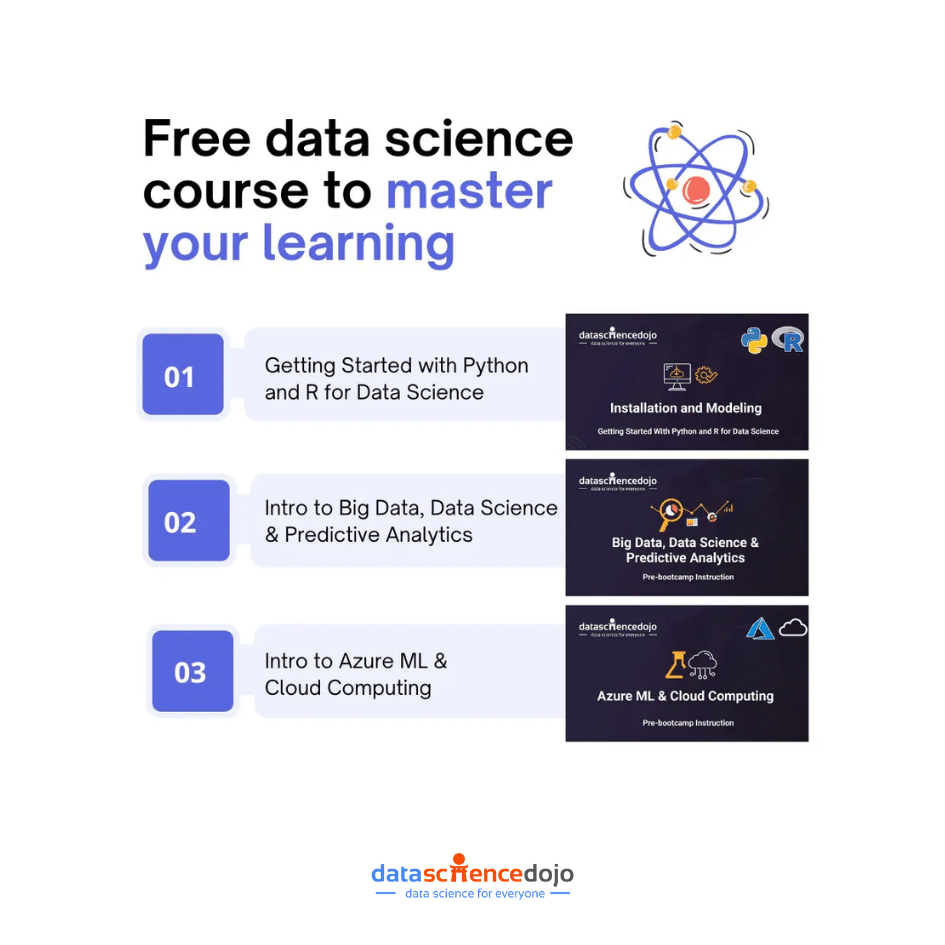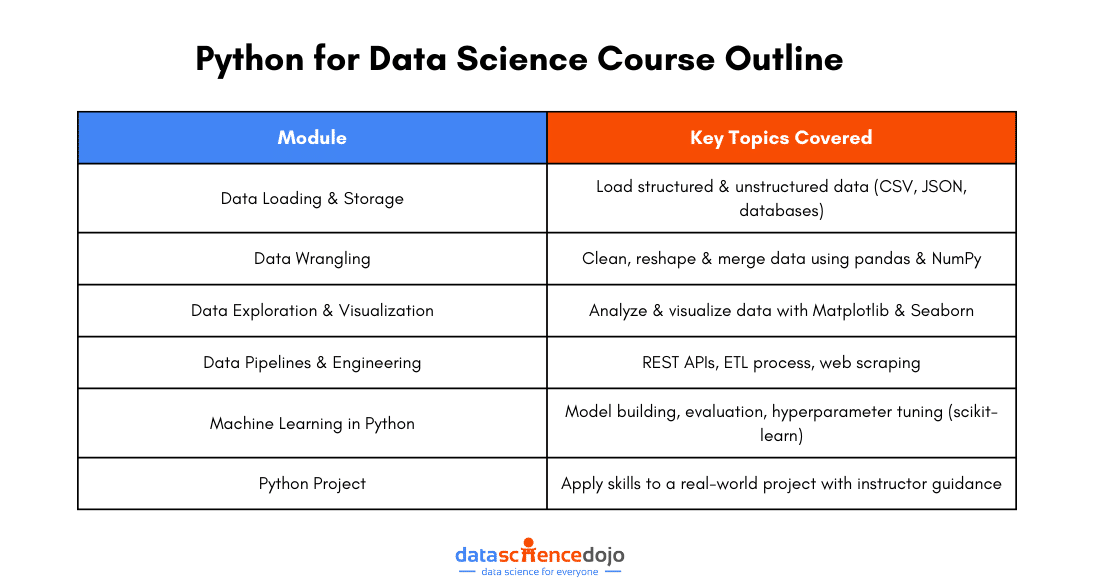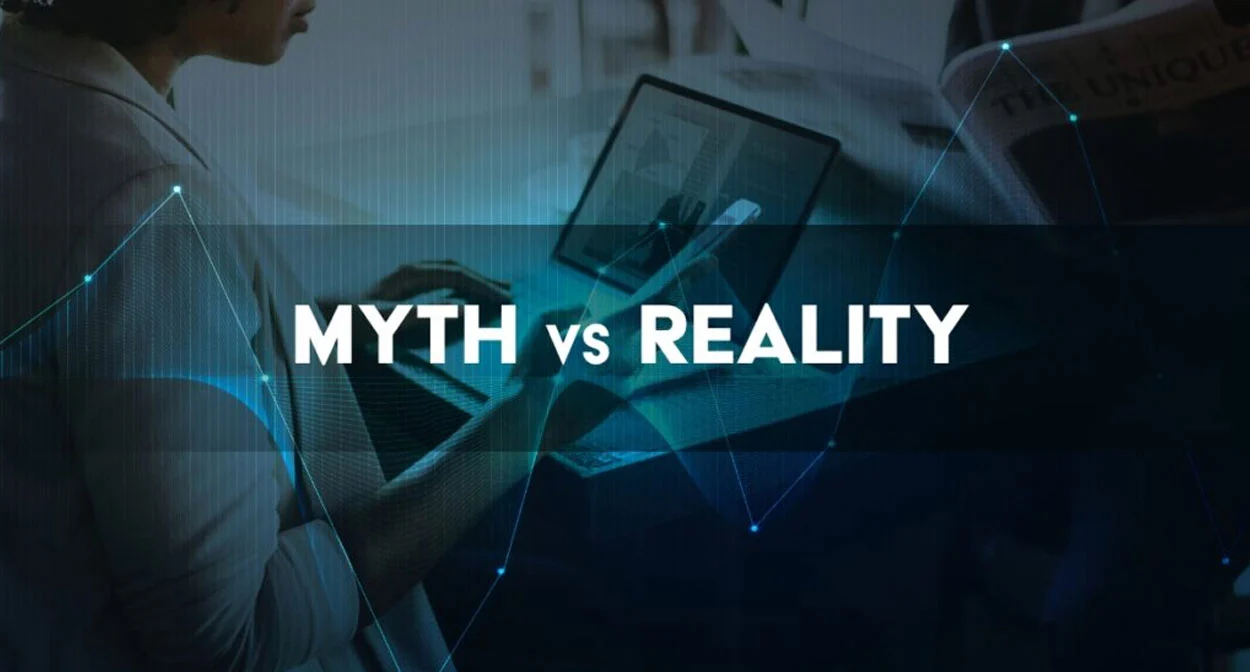Python has become the backbone of data science, offering powerful tools for data analysis, visualization, and machine learning. If you want to harness the power of Python to kickstart your data science journey, Data Science Dojo’s “Introduction to Python for Data Science” course is the perfect starting point.
This course equips you with essential Python skills, enabling you to manipulate data, build insightful visualizations, and apply machine learning techniques. In this blog, we’ll explore how this course can help you unlock the full power of Python and elevate your data science expertise.
Why Learn Python for Data Science?
Python has become the go-to language for data science, thanks to its simplicity, flexibility, and vast ecosystem of open-source libraries. The power of Python for data science lies in its ability to handle data analysis, visualization, and machine learning with ease.
Its easy-to-learn syntax makes it accessible to beginners, while its powerful tools cater to advanced data scientists. With a large community of developers constantly improving its capabilities, Python continues to dominate the data science landscape.
One of Python’s biggest advantages is that it is an interpreted language, meaning you can write and execute code instantly—no need for a compiler. This speeds up experimentation and makes debugging more efficient.
Applications Showcasing the Power of Python for Data Science
1. Data Analysis Made Easy
Python simplifies data analysis by providing libraries like pandas and NumPy, which allow users to clean, manipulate, and process data efficiently. Whether you’re working with databases, CSV files, or APIs, the power of Python for data science enables you to extract insights from raw data effortlessly.
2. Stunning Data Visualizations
Data visualization is essential for making sense of complex datasets, and Python offers several powerful libraries for this purpose. Matplotlib, Seaborn, and Plotly help create interactive and visually appealing charts, graphs, and dashboards, reinforcing the power of Python for data science in storytelling.
3. Powering Machine Learning
Python is a top choice for machine learning, with libraries like scikit-learn, TensorFlow, and PyTorch making it easy to build and train predictive models. Whether it’s image recognition, recommendation systems, or natural language processing, the power of Python for data science makes AI-driven solutions accessible.
4. Web Scraping for Data Collection
Need to gather data from websites? Python makes web scraping simple with libraries like BeautifulSoup, Scrapy, and Selenium. Businesses and researchers leverage the power of Python for data science to extract valuable information from the web for market analysis, sentiment tracking, and competitive research.

Why Choose Data Science Dojo for Learning Python?
With so many Python courses available, choosing the right one can be overwhelming. Data Science Dojo’s “Introduction to Python for Data Science” stands out as a top choice for both beginners and professionals looking to build a strong foundation in Python for data science. Here’s why this course is worth your time and investment:
1. Hands-On, Instructor-Led Training
Unlike self-paced courses that leave you figuring things out on your own, this course offers live, instructor-led training that ensures you get real-time guidance and support. With expert instructors, you’ll learn best practices and gain industry insights that go beyond just coding.
2. Comprehensive Curriculum Covering Essential Data Science Skills
The course is designed to take you from Python basics to real-world data science applications. You’ll learn:
✔ Python fundamentals – syntax, variables, data structures
✔ Data wrangling – cleaning and preparing data for analysis
✔ Data visualization – using Matplotlib and Seaborn for insights
✔ Machine learning – an introduction to predictive modeling
3. Practical Learning with Real-World Examples
Theory alone isn’t enough to master Python for data science. This course provides hands-on exercises, coding demos, and real-world datasets to ensure you can apply what you learn in actual projects.
4. 12 + Months of Learning Platform Access
Even after the live sessions end, you won’t be left behind. The course grants you more than twelve months of access to its learning platform, allowing you to revisit materials, practice coding, and solidify your understanding at your own pace.
5. Earn CEUs and Boost Your Career
Upon completing the course, you receive over 2 Continuing Education Units (CEUs), an excellent addition to your professional credentials. Whether you’re looking to transition into data science or enhance your current role, this certification can give you an edge in the job market.
Python for Data Science Course Outline
Data Science Dojo’s “Introduction to Python for Data Science” course provides a structured, hands-on approach to learning Python, covering everything from data handling to machine learning. Here’s what you’ll learn:
1. Data Loading, Storage, and File Formats
Understanding how to work with data is the first step in any data science project. You’ll learn how to load structured and unstructured data from various file formats, including CSV, JSON, and databases, making data easily accessible for analysis.
2. Data Wrangling: Cleaning, Transforming, Merging, and Reshaping
Raw data is rarely perfect. This module teaches you how to clean, reshape, and merge datasets, ensuring your data is structured and ready for analysis. You’ll master data transformation techniques using Python libraries like pandas and NumPy.
3. Data Exploration and Visualization
Data visualization helps in uncovering trends and insights. You’ll explore techniques for analyzing and visualizing data using popular Python libraries like Matplotlib and Seaborn, turning raw numbers into meaningful graphs and reports.
4. Data Pipelines and Data Engineering
Data engineering is crucial for handling large-scale data. This module covers:
✔ RESTful architecture & HTTP protocols for API-based data retrieval
✔ The ETL (Extract, Transform, Load) process for data pipelines
✔ Web scraping to extract real-world data from websites
5. Machine Learning in Python
Learn the fundamentals of machine learning with scikit-learn, including:
✔ Building and evaluating models
✔ Hyperparameter tuning for improved performance
✔ Working with different estimators for predictive modeling
6. Python Project – Apply Your Skills
The course concludes with a hands-on Python project where you apply everything you’ve learned. With instructor guidance, you’ll work on a real-world project, helping you build confidence and gain practical experience.
Frequently Asked Questions
- How long do I have access to the program content?
Access to the course content depends on the plan you choose at registration. Each plan offers different durations and levels of access, so be sure to check the plan details to find the one that best fits your needs. - What is the duration of the program?
The Introduction to Python for Data Science program spans 5 days with 3 hours of live instruction each day, totaling 15 hours of training. There’s also additional practice available if you want to continue refining your Python skills after the live sessions. - Are there any prerequisites for this program?
No prior experience is required. However, our pre-course preparation includes tutorials on fundamental data science concepts and Python programming to help you get ready for the training. - Are classes taught live or are they self-paced?
Classes are live and instructor-led. In addition to the interactive sessions, you’ll have access to office hours for additional support. While the program isn’t self-paced, homework assignments and practical exercises are provided to reinforce your learning, and lectures are recorded for later review. - What is the cost of the program?
The program cost varies based on the plan you select and any discounts available at the time. For the most up-to-date pricing and information on payment plans, please contact us at [email protected] - What if I have questions during the live sessions or while working on homework?
Our sessions are highly interactive—students are encouraged to ask questions during class. Instructors provide thorough responses, and a dedicated Discord community is available to help you with any questions during homework or outside of class hours. - What different plans are available?
We offer three plans:-
Dojo: Includes 15 hours of live training, pre-training materials, course content, and restricted access to Jupyter notebooks.
-
Guru: Includes everything in the Dojo plan plus bonus Jupyter notebooks, full access to the learning platform during the program, a collaboration forum, recorded sessions, and a verified certificate from the University of New Mexico worth 2 Continuing Education Credits.
-
Sensei: Includes everything in the Guru plan, along with one year of access to the learning platform, Jupyter notebooks, collaboration forums, recorded sessions, office hours, and live support throughout the program.
-
- Are there any discounts available?
Yes, we are offering an early-bird discount on all three plans. Check the course page for the latest discount details. - How much time should I expect to spend on class and homework?
Each class is 3 hours per day, and you should plan for an additional 1–2 hours of homework each night. Our instructors and teaching assistants are available during office hours from Monday to Thursday for extra help. - How do I register for the program?
To register, simply review the available packages on our website and sign up for the upcoming cohort. Payments can be made online, via invoice, or through a wire transfer.
Explore the Power of Python for Data Science
The power of Python for data science makes it the top choice for data professionals. Its simplicity, vast libraries, and versatility enable efficient data analysis, visualization, and machine learning.
Mastering Python can open doors to exciting opportunities in data-driven careers. A structured course, like the one from Data Science Dojo, ensures hands-on learning and real-world application.
Start your Python journey today and take your data science skills to the next level









